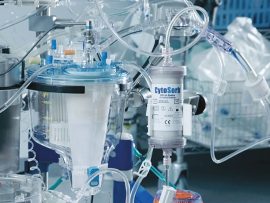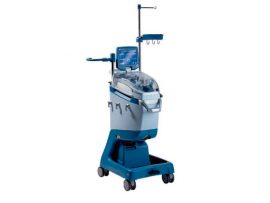Abstract Objectives Cardiac surgery induces systemic inflammatory response syndrome (SIRS), leading to higher morbidity and mortality. There are no individualized predictors for worse outcomes or biomarkers for the multifactorial, excessive..
Read MoreAbstract Background Extracorporeal membrane oxygenation (ECMO) not only significantly improves survival rates in severely ill neonates but also is associated with long-term neurodevelopmental issues. To systematically review the available literature..
Read MoreAbstract Extracorporeal Cardiopulmonary Resuscitation (ECPR) is an emerging approach to cardiac arrest. We present two contrasting cases from a high-volume extracorporeal membrane oxygenation (ECMO) center (defined as greater than 30..
Read MoreAbstract Continuous negative abdominal pressure (CNAP) therapy effectively provides respiratory support in patients with respiratory failure and severe obesity; however, its use in clinical practice remains limited. In this case,..
Read MoreExploring CPB Physiology & IABP Applications: Essential Insights for Perfusionists Mastering Z-BUF in Hyperkalemia. My Near Misses. Integration of the PrismaFlex CRRT machine into your CMO circuit ..
Read MoreAbstract Objectives: To investigate the impact of a cytokine haemoadsorption (HA) device (CytoSorb®) on inflammatory markers and patients' outcome during aortic root surgery. Methods: Prospective, observational study including all-comers with quasi-randomization by..
Read MoreAbstract Background Impaired cognition is a major predisposing factor for postoperative delirium but it is not systematically assessed. Anesthesia and surgery may cause postoperative delirium by affecting brain integrity. Neurofilament..
Read MoreAbstract Background Bleeding after cardiac surgery is common and continues to require 10–20% of the national blood supply. Transfusion of allogeneic blood is associated with increased morbidity and mortality. Excessive..
Read MoreAbstract Aims The aim of this trial was to compare the clinical effects of intraoperative haemoadsorption versus standard care in patients undergoing orthotopic heart transplantation (OHT). Methods and results In..
Read MoreAbstract Introduction Vacuum assisted venous drainage (VAVD) is widely adopted in minimally invasive cardiac surgery. VAVD enables the advantage of using smaller cannulae in a reduced surgical field while allowing..
Read MoreAbstract Background The relationship between hyperlactatemia and prognosis after cardiopulmonary bypass (CPB) is controversial, and some studies ignore the presence of lactic acidosis in patients with severe hyperlactacemia. This study..
Read MoreAbstract Background During cardiac surgery, transcranial Doppler (TCD) represents a non-invasive modality that allows measurement of red blood cell flow velocities in the cerebral arteries. TCD can also be used..
Read MoreAbstract Objectives The aim of this study was to evaluate the incidence of transfusions, including red blood cells (RBC), platelets, and fresh frozen plasma (FFP) during and after coronary artery..
Read MoreAbstract BACKGROUND: Preoperative anemia is associated with adverse outcomes in cardiac surgery, yet it remains unclear what proportion of this association is mediated through red blood cell (RBC) transfusions. METHODS: ..
Read MoreAbstract We characterize the anatomy and function of never before studied total artificial hearts (TAHs) using established methods for testing mechanical circulatory support (MCS) devices. A historical review of TAHs..
Read MoreAbstract Background This exploratory analysis of the randomized controlled Cerebral Protection Evaluation CardioLink-3 trial sought to determine if cerebral during elective proximal arch repair is associated with detrimental postoperative neuroradiologic and neurofunctional..
Read MoreAbstract Our aim is to present an updated overview of the erythrocyte metabolism highlighting its richness and complexity. We have manually collected and connected the available biochemical pathways and integrated..
Read MoreAbstract Objective Equivalent and clinical outcomes have been shown with the use of del Nido (DC) compared with blood (BC) in adult isolated and valve patients. However, its safety and efficacy in cardiac procedures..
Read MoreAbstract Background One of the leading causes of maternal death worldwide is severe obstetric haemorrhage after childbirth. Use of intraoperative cell salvage is strongly recommended by international guidelines on patient..
Read MoreAbstract OBJECTIVES Sepsis caused by infective endocarditis (IE), due to Staphylococcus aureus, is associated with significant morbidity and mortality. Blood purification using haemoadsorption (HA) may attenuate the inflammatory response. We investigated..
Read MoreAbstract Background Surgical pulmonary artery thrombectomy is a well-established emergency treatment for massive pulmonary embolism (PE) in which fibrinolysis or thrombolysis are not effective. However, surgery for massive PE that..
Read MoreAbstract Objective To analyze the efficacy of isolating the upper body circulation from the lower body (isolation technique) in reducing the risk of during with severe undergoing . Methods Between 2006 and 2019, 156..
Read MoreAbstract Background: En bloc removal of the kidney with tumor thrombus excision in a multidisciplinary team remains the standard treatment for renal cell carcinoma (RCC) with tumor thrombus extension. In..
Read MoreAbstract Background Thromboembolic stroke continues to be by far the most common severe adverse event in patients supported with mechanical circulatory assist devices. Feasibility of using Doppler ultrasound to detect..
Read MoreAbstract Delirium, a form of acute cerebral dysfunction, is a common complication of postoperative cardiac surgery in children. It is strongly associated with adverse outcomes, including prolonged hospitalization, increased mortality,..
Read MoreAbstract Introduction: To understand the behavior of platelet volume indices and the von Willebrand factor (VWF), in vitro experiments using whole human blood were performed with extracorporeal circulation (ECC) circuits,..
Read MoreAbstract Following surgery, over 50% of cardiac surgery patients report anxiety, stress and/or depression, with at least 10% meeting clinical diagnoses, which can persist for more than a year. Psychological..
Read MoreAbstract Background This study investigated whether intraoperative blood salvage was associated with coagulation disorder diagnosed by conventional coagulation tests and thromboelastography (TEG) after cardiopulmonary bypass (CPB). Study design and methods..
Read MoreAbstract BACKGROUND: Deep hypothermia has been the standard for hypothermic circulatory arrest (HCA) during aortic arch surgery. However, centers worldwide have shifted toward lesser hypothermia with antegrade cerebral perfusion. This..
Read MoreAbstract Cardiac surgery with cardiopulmonary bypass (CBP) is essential for different cardiac procedures in order to perform surgery with a clear sight field. To safely perform surgery with CPB and..
Read More




















